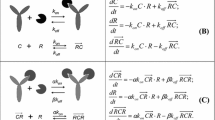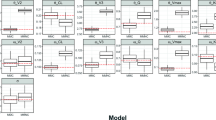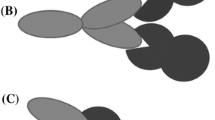Abstract
The paper focuses on approximations of the target-mediated drug disposition (TMDD) model as applied to pharmacodynamic (target kinetics) modeling. The TMDD equation for the total target concentration is shown to coincide with the indirect response model with stimulation or inhibition of elimination. This correspondence allows estimation of pharmacodynamic TMDD parameters and unobservable free target concentrations using indirect-response models. The ability of the TMDD model and its approximations to estimate the unobservable free target concentration is investigated by simulation. Pharmacokinetic parameters used for simulations were parameters typical for monoclonal antibodies. TMDD binding and target turnover parameters were similar to those estimated for omalizumab. Free drug and total target concentrations were measured. The simulated population PK–PD study demonstrated that for drugs with TMDD, indirect-response models are in fact mechanistic models that can be used to estimate TMDD model parameters and unobservable free target concentrations that are important for pharmacodynamic modeling.



Similar content being viewed by others
References
Mager DE, Jusko WJ (2001) General pharmacokinetic model for drugs exhibiting target-mediated drug disposition. J Pharmacokinet Pharmacodyn 28:507–532
Mager DE, Krzyzanski W (2005) Quasi-equilibrium pharmacokinetic model for drugs exhibiting target-mediated drug disposition. Pharm Res 22(10):1589–1596
Gibiansky L, Gibiansky E, Kakkar T, Ma P (2008) Approximations of the target-mediated drug disposition model and identifiability of model parameters. J Pharmacokinet Pharmacodyn 35(5):573–591
Gibiansky L, Gibiansky E (2009) Target-mediated drug disposition model: approximations, identifiability of model parameters, and applications to the population pharmacokinetic––pharmacodynamic modeling of biologics. Expert Opinion Drug Metab Toxicol 5(7):803–812
Dayneka NL, Garg V, Jusko WJ (1993) Comparison of four basic models of indirect pharmacodynamic responses. J Pharmacokinet Biopharm 21:457–478
Bauer RJ, Russel DL, White RL, Murray MJ, Garovoy MR (1999) Population pharmacokinetics and pharmacodynamics of the anti-CD11a antibody hu1124 in human subjects with psoriasis. J Pharmacokinet Biopharm 27(4):397–420
Kuester K, Kloft C (2006) Pharmacokinetics of monoclonal antibodies. In: Meibohm B (ed) Pharmacokinetics and pharmacodynamics of biotech drugs: principles and case studies in drug development. WILEY-VCH Verlag GmbH & Co, KGaA, Weinheim, pp 45–91
Mould DR, Sweeney KD (2007) A review of the pharmacokinetics and pharmacodynamics of monoclonal antibodies––mechanistic modeling applied to drug development. Current Opinion Drug Discov Devel 10(1):84–96
Wand W, Wang EQ, Balthasar JP (2008) Monoclonal antibody pharmacokinetics and pharmacodynamics. Clin Pharmacol Ther 84(5):548–558
Beal SL, Sheiner LB, Boeckmann AJ (eds) (1989–2007) NONMEM users guides. Icon Development Solutions, Ellicott City, MD, USA
Nonmem VI®. NONMEM Project Group. University of California at San Francisco: San Francisco, CA, USA
Meno-Tetang GML, Lowe PJ (2005) On the prediction of the human response: a recycled mechanistic pharmacokinetic/pharmacodynamic approach. Basic Clin Pharmacol Toxicol 96(3):182–192
Hayashi N, Tsukamoto Y, Sallas WM, Lowe PJ (2007) A mechanism-based binding model for the population pharmacokinetics and pharmacodynamics of omalizumab. Br J Clin Pharmacol 63(5):548–561
Author information
Authors and Affiliations
Corresponding author
Rights and permissions
About this article
Cite this article
Gibiansky, L., Gibiansky, E. Target-mediated drug disposition model: relationships with indirect response models and application to population PK–PD analysis. J Pharmacokinet Pharmacodyn 36, 341–351 (2009). https://doi.org/10.1007/s10928-009-9125-9
Received:
Accepted:
Published:
Issue Date:
DOI: https://doi.org/10.1007/s10928-009-9125-9




